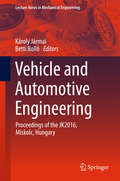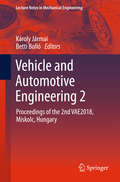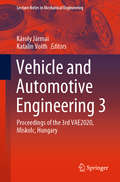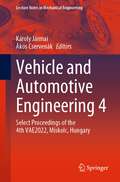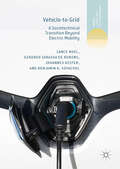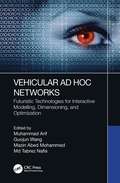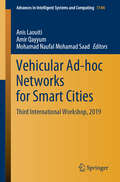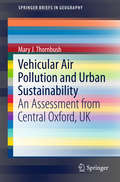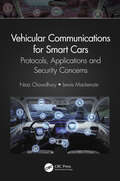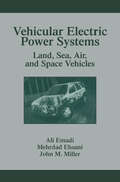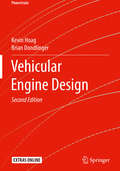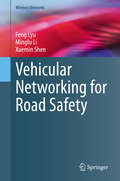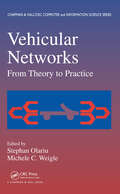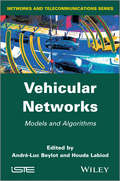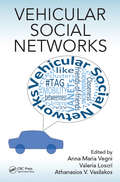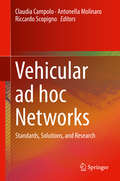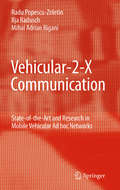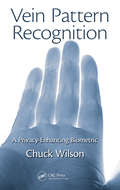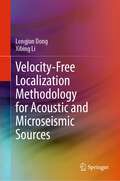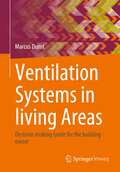- Table View
- List View
Vehicle and Automotive Engineering
by Károly Jármai Betti BollóThis book presents the proceedings of the first vehicle engineering and vehicle industry conference. It captures the outcome of theoretical and practical studies as well as the future development trends in a wide field of automotive research.The themes of the conference include design, manufacturing, economic and educational topics.
Vehicle and Automotive Engineering 2: Proceedings of the 2nd VAE2018, Miskolc, Hungary (Lecture Notes in Mechanical Engineering)
by Károly Jármai Betti BollóThis book presents the proceedings of the second Vehicle Engineering and Vehicle Industry conference, reflecting the outcomes of theoretical and practical studies and outlining future development trends in a broad field of automotive research. The conference’s main themes included design, manufacturing, economic and educational topics.
Vehicle and Automotive Engineering 3: Proceedings of the 3rd VAE2020, Miskolc, Hungary (Lecture Notes in Mechanical Engineering)
by Károly Jármai Katalin VoithThis book presents the proceedings of the third Vehicle and Automotive Engineering conference, reflecting the outcomes of theoretical and practical studies and outlining future development trends in a broad field of automotive research. The conference’s main themes included design, manufacturing, economic and educational topics.
Vehicle and Automotive Engineering 4: Select Proceedings of the 4th VAE2022, Miskolc, Hungary (Lecture Notes in Mechanical Engineering)
by Károly Jármai Ákos CservenákThis book presents the selected proceedings of the (third) fourth Vehicle and Automotive Engineering conference, reflecting the outcomes of theoretical and practical studies and outlining future development trends in a broad field of automotive research. The conference’s main themes included design, manufacturing, economic and educational topics.
Vehicle-Manipulator Systems
by Jan Tommy Gravdahl Pål Johan From Kristin Ytterstad PettersenFurthering the aim of reducing human exposure to hazardous environments, this monograph presents a detailed study of the modeling and control of vehicle-manipulator systems. The text shows how complex interactions can be performed at remote locations using systems that combine the manipulability of robotic manipulators with the ability of mobile robots to locomote over large areas. The first part studies the kinematics and dynamics of rigid bodies and standard robotic manipulators and can be used as an introduction to robotics focussing on robust mathematical modeling. The monograph then moves on to study vehicle-manipulator systems in great detail with emphasis on combining two different configuration spaces in a mathematically sound way. Robustness of these systems is extremely important and Modeling and Control of Vehicle-manipulator Systems effectively represents the dynamic equations using a mathematically robust framework. Several tools from Lie theory and differential geometry are used to obtain globally valid representations of the dynamic equations of vehicle-manipulator systems. The specific characteristics of several different types of vehicle-manipulator systems are included and the various application areas of these systems are discussed in detail. For underwater robots buoyancy and gravity, drag forces, added mass properties, and ocean currents are considered. For space robotics the effects of free fall environments and the strong dynamic coupling between the spacecraft and the manipulator are discussed. For wheeled robots wheel kinematics and non-holonomic motion is treated, and finally the inertial forces are included for robots mounted on a forced moving base. Modeling and Control of Vehicle-manipulator Systems will be of interest to researchers and engineers studying and working on many applications of robotics: underwater, space, personal assistance, and mobile manipulation in general, all of which have similarities in the equations required for modeling and control.
Vehicle-to-Grid: A Sociotechnical Transition Beyond Electric Mobility (Energy, Climate and the Environment)
by Benjamin K. Sovacool Lance Noel Gerardo Zarazua de Rubens Johannes KesterThis book defines and charts the barriers and future of vehicle-to-grid technology: a technology that could dramatically reduce emissions, create revenue, and accelerate the adoption of battery electric cars. This technology connects the electric power grid and the transportation system in ways that will enable electric vehicles to store renewable energy and offer valuable services to the electricity grid and its markets. To understand the complex features of this emergent technology, the authors explore the current status and prospect of vehicle-to-grid, and detail the sociotechnical barriers that may impede its fruitful deployment. The book concludes with a policy roadmap to advise decision-makers on how to optimally implement vehicle-to-grid and capture its benefits to society while attempting to avoid the impediments discussed earlier in the book.
Vehicle-to-Vehicle and Vehicle-to-Infrastructure Communications: A Technical Approach
by Fei HuThis book focuses on the most critical technical aspects of vehicle-to-vehicle (V2V) and vehicle-to-infrastructure (V2I) communications. It covers the smart city concept and architecture and explains how V2V and V2I fit into it. It describes the wireless communication protocols for V2V and V2I. It then explains the hardware design process for vehicle communication transceiver and antenna systems. It explains next-generation wireless technologies and their requirements for vehicle communication protocols. Case studies provide the latest V2V and V2I commercial design details. Finally, it describes how to implement vehicle communication protocol from practical hardware design angle.
Vehicle–Track Coupled Dynamics: Theory and Applications
by Wanming ZhaiThis book systematically presents the theory, numerical implementation, field experiments and practical engineering applications of the ‘Vehicle–Track Coupled Dynamics’. Representing a radical departure from classic vehicle system dynamics and track dynamics, the vehicle–track coupled dynamics theory considers the vehicle and track as one interactive and integrated system coupled through wheel–rail interaction. This new theory enables a more comprehensive and accurate solution to the train–track dynamic interaction problem which is a fundamental and important research topic in railway transportation system, especially for the rapidly developed high-speed and heavy-haul railways. It has been widely applied in practical railway engineering.Dr. Wanming Zhai is a Chair Professor of Railway Engineering at Southwest Jiaotong University, where he is also chairman of the Academic Committee and Director of the Train and Track Research Institute. He is a member of the Chinese Academy of Sciences and one of the leading scientists in railway system dynamics. Professor Zhai is Editor-in-Chief of both the International Journal of Rail Transportation, published by Taylor & Francis Group, and the Journal of Modern Transportation, published by Springer. In addition, he is a trustee of the International Association for Vehicle System Dynamics, Vice President of the Chinese Society of Theoretical and Applied Mechanics, and Vice President of the Chinese Society for Vibration Engineering.
Vehicular Ad Hoc Networks: Futuristic Technologies for Interactive Modelling, Dimensioning, and Optimization
by Muhammad ArifWith the evolution of technology and sudden growth in the number of smart vehicles, traditional Vehicular Ad hoc NETworks (VANETs) face several technical challenges in deployment and management due to less flexibility, scalability, poor connectivity, and inadequate intelligence. VANETs have raised increasing attention from both academic research and industrial aspects resulting from their important role in driving assistant system. Vehicular Ad Hoc Networks focuses on recent advanced technologies and applications that address network protocol design, low latency networking, context-aware interaction, energy efficiency, resource management, security, human-robot interaction, assistive technology and robots, application development, and integration of multiple systems that support Vehicular Networks and smart interactions. Simulation is a key tool for the design and evaluation of Intelligent Transport Systems (ITS) that take advantage of communication-capable vehicles in order to provide valuable safety, traffic management, and infotainment services. It is widely recognized that simulation results are only significant when realistic models are considered within the simulation tool chain. However, quite often research works on the subject are based on simplistic models unable to capture the unique characteristics of vehicular communication networks. The support that different simulation tools offer for such models is discussed, as well as the steps that must be undertaken to fine-tune the model parameters in order to gather realistic results. Moreover, the book provides handy hints and references to help determine the most appropriate tools and models. This book will promote best simulation practices in order to obtain accurate results.
Vehicular Ad-hoc Networks for Smart Cities: Third International Workshop, 2019 (Advances in Intelligent Systems and Computing #1144)
by Anis Laouiti Amir Qayyum Mohamad Naufal Mohamad SaadThis book presents selected papers from the Third International Workshop on Vehicular Ad-hoc Networks for Smart Cities, Paris, 2019. Future smart cities are well placed to profit from extraordinary mobile infrastructures. IWVSC'2019 brings together experts from both academia and industry to discuss recent developments in vehicular networking technologies and their interaction with future smart cities in order to promote further research activities and challenges.
Vehicular Air Pollution and Urban Sustainability
by Mary J. ThornbushThis Brief examines the impact of the Oxford Transport Strategy in central Oxford as a means of assessing the effect of reduced traffic congestion in the city centre on its sustainability. Air pollution (from vehicular traffic) has been monitored at three locations in central Oxford on the High Street, St Aldates and St Ebbes (background monitoring station). There is a further monitoring site situated in East Oxford, but this one is not considered to be central. Based on long-term monitoring at these monitoring stations, a deliberation of urban sustainability is presented. Implications are considered for long-term planning and green design in particular is part of the discussion. More specifically, urban greening strategies are presented as (soft engineering) approaches to controlling air pollution problems at this urban location. In the context of low carbon cities, green walls are assessed as they affect urban greening and energy conservation, as they enhance insulation on the exterior of solid wall buildings. Urban sustainability is best monitored using decades of data rather than just years. The Oxford Transport Strategy (OTS) was implemented in central Oxford, UK in 2001 and now a record of at least a decade of monitoring data is available for such a longer-term assessment. This work revisits the OTS from long after its implementation in the Oxford city centre and specifically examines the impact of reduced traffic congestion on sustainability. This includes address of traffic congestion, air pollution (from vehicular or traffic pollution) and the effects on the urban environment, including buildings. In parallel to this, the role of urban vegetation is considered as a sink for a variety of pollutants. Green walls, as part of urban greening, have implications for low carbon cities in the context of urban heat islands and global warming.
Vehicular Communications for Smart Cars: Protocols, Applications and Security Concerns
by Lewis Mackenzie Niaz ChowdhuryThis book covers a wide range of topics from the smart transportation domain. It discusses protocols, applications and security concerns in various vehicular networks using examples and easy-to-understand figures. The first four chapters focus on vehicular network protocols and applications, while the remaining four chapters incorporate security, trust and privacy issues with examples from real-life cases. The book concludes with a vision of what to expect in the near future and will be an invaluable resource for anybody interested in this nascent technology and its variegated applications. Dr. Niaz Chowdhury is a postdoctoral research associate at the Knowledge Media Institute, the Open University in England. Dr. Lewis M. Mackenzie is a senior lecturer in computing science at the University of Glasgow.
Vehicular Electric Power Systems: Land, Sea, Air, and Space Vehicles (Power Engineering (Willis))
by Mehrdad Ehsani John M. Miller Ali EmadiThis reference acquaints professionals with trends and challenges in the development of more electric vehicles (MEVs) using detailed examples and comprehensive discussions on advanced MEV power system architectures, characteristics, and dynamics. The book focuses on real-world applications and highlights issues related to system stability, as well as challenges faced during and after implementation. Heralding a new wave of advances in power system technology, Vehicular Electric Power Systems probes innovations in the development of more electric vehicles for improved maintenance, support, endurance, safety, and cost-efficiency in automotive, aerospace, and marine vehicle engineering.
Vehicular Engine Design
by Kevin Hoag Brian DondlingerThis book provides an introduction to the design and mechanical development of reciprocating piston engines for vehicular applications. Beginning from the determination of required displacement and performance, coverage moves into engine configuration and architecture. Critical layout dimensions and design trade-offs are then presented for pistons, crankshafts, engine blocks, camshafts, valves, and manifolds. Coverage continues with material strength and casting process selection for the cylinder block and cylinder heads. Each major engine component and sub-system is then taken up in turn, from lubrication system, to cooling system, to intake and exhaust systems, to NVH. For this second edition latest findings and design practices are included, with the addition of over sixty new pictures and many new equations.
Vehicular Networking
by Christoph Sommer Falko DresslerWith this essential guide to vehicular networking, you will learn about everything from conceptual approaches and state-of-the-art protocols, to system designs and their evaluation. Covering both in- and inter-vehicle communication, this comprehensive work outlines the foundations of vehicular networking as well as demonstrating its commercial applications, from improved vehicle performance, to entertainment, and traffic information systems. All of this is supported by in-depth case studies and detailed information on proposed protocols and solutions for access technologies and information dissemination, as well as topics on rulemaking, regulations, and standardization. Importantly, for a field which is attracting increasing commercial interest, you will learn about the future trends of this technology, its problems, and solutions to overcome them. Whether you are a student, a communications professional or a researcher, this is an invaluable resource.
Vehicular Networking for Road Safety (Wireless Networks)
by Xuemin Shen Minglu Li Feng LyuThe topics addressed in this book are crucial for both the academic community and industry, since the vehicular network has become an essential building block for intelligent transportation systems. The systematic principle of this book provides valuable guidance on the deployment and implementation of V2X-enabled road-safety applications. In addition, this book carries out structured technologies from the MAC layer to the link and network layer, which can provide a general introduction for interested readers with a comprehensive understanding of applying vehicular networks in enhancing road safety, and offers a systematized view for researchers and practitioners in the field of vehicular networks to help them optimize and improve the desired vehicular communication systems. Road safety has always been the first priority for daily commuters on the road. Vehicular networks can be an effective solution to enhance road safety, via which vehicles can exchange cooperative awareness messages rapidly, contributing to better situation awareness and maneuvering cooperation. However, with the fast-changing network topology, intermittent wireless link, and dynamic traffic density, it is challenging to achieve satisfying network performance. This book introduces the background of vehicular networks, provides a comprehensive overview of networking techniques in supporting road-safety applications, states the technical motivations per the MAC, link, and network layer, and proposes/designs vehicular networking technologies at the corresponding layer respectively to guarantee low-latency and reliable V2X communications for road-safety applications. By extending the proposed networking technologies to support all types of vehicular services, this book also outlines open issues and research directions in future 5G and beyond vehicular networks.
Vehicular Networks: From Theory to Practice (Chapman & Hall/CRC Computer and Information Science Series)
by Stephan Olariu Michele C. WeigleIn spite of their importance and potential societal impact, there is currently no comprehensive source of information about vehicular ad hoc networks (VANETs). Cohesively integrating the state of the art in this emerging field, Vehicular Networks: From Theory to Practice elucidates many issues involved in vehicular networking, including traffic eng
Vehicular Networks: Models and Algorithms
by André-Luc Beylot Houda LabiodOver the last few years vehicular networks have been receiving a lot of attention from academia, industry, standardization bodies, and the various transportation agencies and departments of many governments around the world. It is envisaged in the next decade that the Intelligent Transportation System (ITS) will become an essential part of our daily life. This book describes models and/or algorithms designed to investigate evolutionary solutions to overcome important issues such as congestion control, routing, clustering, interconnection with long-term evolution (LTE) and LTE advanced cellular networks, traffic signal control and analysis of performances through simulation tools and the generation of vehicular mobility traces for network simulations. It provides an up-to-date progress report on the most significant contributions carried out by the specialized research community in the various fields concerned, in terms of models and algorithms. The proposals and new directions explored by the authors are highly original, and a rather descriptive method has been chosen, which aims at drawing up complete states of the art as well as providing an overall presentation of the personal contributions brought by the authors and clearly illustrating the advantages and limitations as well as issues for future work. Contents 1. Introduction 2. Congestion Control for Safety Vehicular Ad-Hoc Networks 3. Inter-Vehicle Communication for the Next Generation of Intelligent Transport System: Trends in Geographic Ad Hoc Routing Techniques 4. CONVOY: A New Cluster-Based Routing Protocol for Vehicular Networks 5. Complementarity between Vehicular Networks and LTE Networks 6. Gateway Selection Algorithms in a Hybrid VANET-LTE Advanced Network 7. Synthetic Mobility Traces for Vehicular Networking 8. Traffic Signal Control Systems and Car-to-Car Communications About the Authors André-Luc Beylot is Professor in the Telecommunication and Network Department of the ENSEEIHT of IRIT-T, University of Toulouse in France. Houda Labiod is Associate Professor at Telecom ParisTech in the INFRES (Computer Science and Network) Department, France.
Vehicular Social Networks
by Anna Maria Vegni; Valeria Loscrí; Athanasios V. VasilakosThe book provides a comprehensive guide to vehicular social networks. The book focuses on a new class of mobile ad hoc networks that exploits social aspects applied to vehicular environments. Selected topics are related to social networking techniques, social-based routing techniques applied to vehicular networks, data dissemination in VSNs, architectures for VSNs, and novel trends and challenges in VSNs. It provides significant technical and practical insights in different aspects from a basic background on social networking, the inter-related technologies and applications to vehicular ad-hoc networks, the technical challenges, implementation and future trends.
Vehicular ad hoc Networks
by Riccardo Scopigno Claudia Campolo Antonella MolinaroThis book presents vehicular ad-hoc networks (VANETs) from the their onset, gradually going into technical details, providing a clear understanding of both theoretical foundations and more practical investigation. The editors gathered top-ranking authors to provide comprehensiveness and timely content; the invited authors were carefully selected from a list of who's who in the respective field of interest: there are as many from Academia as from Standardization and Industry sectors from around the world. The covered topics are organized around five Parts starting from an historical overview of vehicular communications and standardization/harmonization activities (Part I), then progressing to the theoretical foundations of VANETs and a description of the day-one standard-compliant solutions (Part II), hence going into details of vehicular networking and security (Part III) and to the tools to study VANETs, from mobility and channel models, to network simulators and field trial methodologies (Part IV), and finally looking into the future of VANETs by investigating alternative, complementary communication technologies, innovative networking paradigms and visionary applications (Part V). The way the content is organized, with a differentiated level of technical details, makes the book a valuable reference for a large pool of target readers ranging from undergraduate, graduate and PhD students, to wireless scientists and engineers, to service providers and stakeholders in the automotive, ITS, ICT sectors.
Vehicular-2-X Communication
by Radu Popescu-Zeletin Ilja Radusch Mihai Adrian RiganiThe European Car-to-Car Communication Consortium in relation with the American Vehicle Safety Communication project has been playing a key role in the development of the concepts and technologies which are now at the origin of the standardization activities and research projects (PREVENT, SAFESPOT, CVIS) being introduced. Many safety applications (some of them being summarized here) will use this standard infrastructure for contributing to a safer road environment. Along the ISO OSI reference model the authors describe medium access control, routing in WAVE/DSRC (Dedicated Short Range Communications), 802.11p, and accompanying standards based on the communication architecture defined by the Car-to-Car Communication Consortium and the National Vehicle Infrastructure Integration Consortium (VIIC), as within the Federal ITS Program (RITA). Furthermore, this book introduces and describes future automotive applications such as cooperative driving utilizing such car-2-X (or vehicle-2-x) communication between vehicles and road infrastructure. Validation of these novel applications is a must before market introduction. Therefore this book introduces comprehensive simulation environment combining existing approaches for application, traffic and network simulation.
Vein Pattern Recognition: A Privacy-Enhancing Biometric
by Chuck WilsonAs one of the most promising biometric technologies, vein pattern recognition (VPR) is quickly taking root around the world and may soon dominate applications where people focus is key. Among the reasons for VPR‘s growing acceptance and use: it is more accurate than many other biometric methods, it offers greater resistance to spoofing, it focuses
Velocipedomania: A Cultural History of the Velocipede in France
by Seth Whidden Corry CropperWhen blacksmith Pierre Michaux affixed pedals to the front axle of a two-wheeled scooter with a seat, he helped kick off a craze known as velocipedomania, which swept France in the late 1860s. The immediate forerunner of the bicycle, the velocipede similarly reflected changing cultural attitudes and challenged gender norms. Velocipedomania is the first in-depth study of the velocipede fad and the popular culture it inspired. It explores how the device was hailed as a symbol of France’s cutting-edge technological advancements, yet also marketed as an invention with a noble pedigree, born from the nation’s cultural and literary heritage. Giving readers a window into the material culture and enthusiasms of Second Empire France, it provides the first English translations of 1869’s Manual of the Velocipede, 1868’s Note on Monsieur Michaux’s Velocipede, and the 1869 operetta Dagobert and his Velocipede. It also reprints scores of rare images from newspapers and advertisements, analyzing how these magnificent machines captured the era’s visual imagination. By looking at how it influenced French attitudes towards politics, national identity, technology, fashion, fitness, and gender roles, this book shows how the short-lived craze of velocipedomania had a big impact.
Velocity-Free Localization Methodology for Acoustic and Microseismic Sources
by Longjun Dong Xibing LiIn this book, we proposed velocity-free localization methods for acoustic and microseismic sources. This method does not require predetermination of wave velocity, which is a dynamically adjusted free real-time parameter. These methods solve the problem of large localization error caused by the difference between measured wave velocity and actual wave velocity in the source area and greatly improve the positioning accuracy. They are suitable for complex structures where the wave velocity changes dynamically in time and space, such as mines, bridges, buildings, pavements, loaded mechanical structures, dams, geothermal mining, oil extraction, and other engineering fields. This book includes progress in the development of localization methods, factors affecting the accuracy of source localization, analytical methods without the pre-measured wave velocity, velocity-free numerical methods for localizing acoustic sources, combined optimal velocity-free localization methods, velocity-free source localization considering complex paths of spatial structures, and theories as well as some cases of engineering applications of these methods.
Ventilation Systems in living Areas: Decision-making Guide for the building owner
by Marcus DunstIIn this book the reader can get an overview of different ventilation systems in simple and understandable terms. Complicated details of standards and regulations are not discussed, but the subject of ventilation systems should be made effortlessly accessible to an interested audience. The building owner must ultimately make the decision as to whether and which system should be installed in his building. The experience of the last 20 years shows that the client is usually only informed about one or two systems. The craftsman, architect or property developer often cannot provide more. This book is intended to help the client to make the right "ventilation decision". It shows a cross-section of different systems, with their advantages and disadvantages and offers a small insight into the variety of different manufacturers of ventilation systems.
